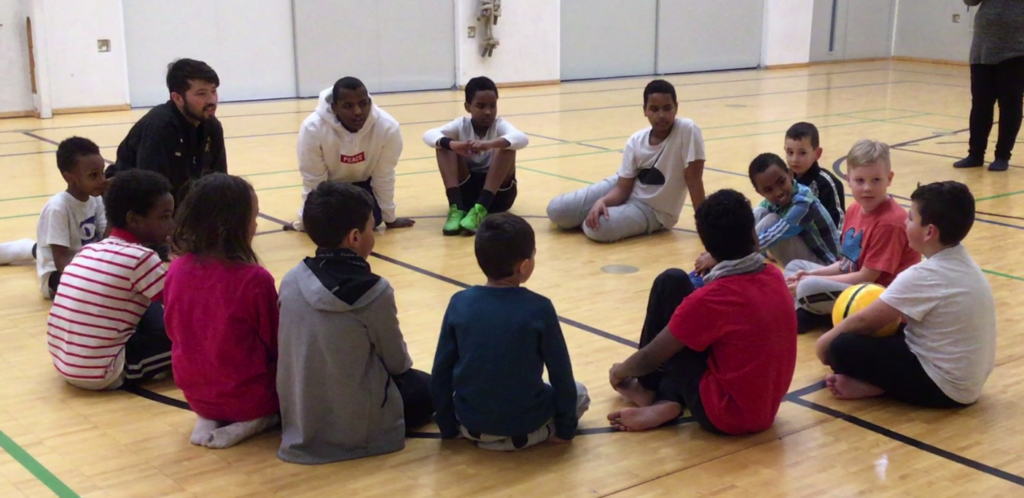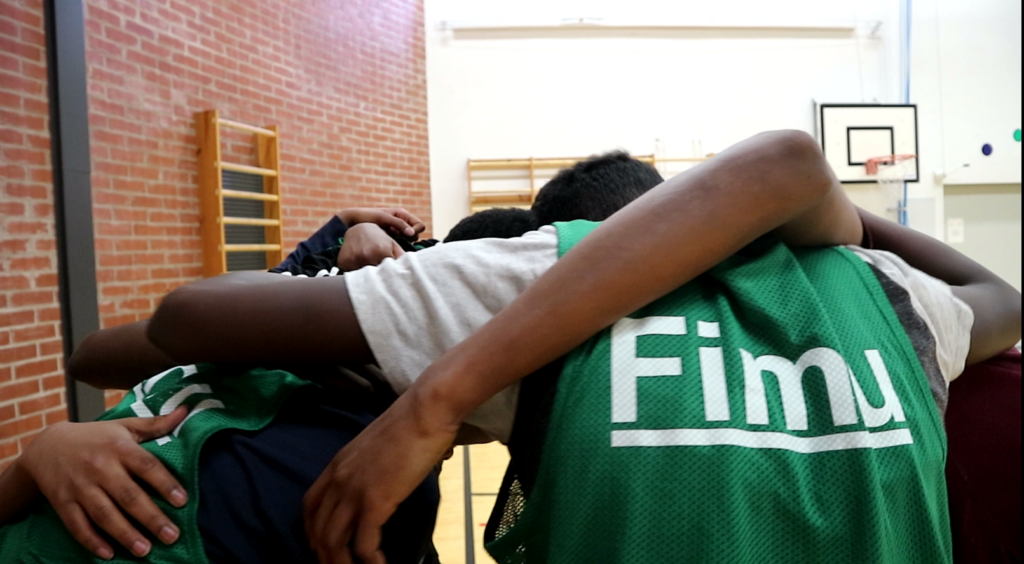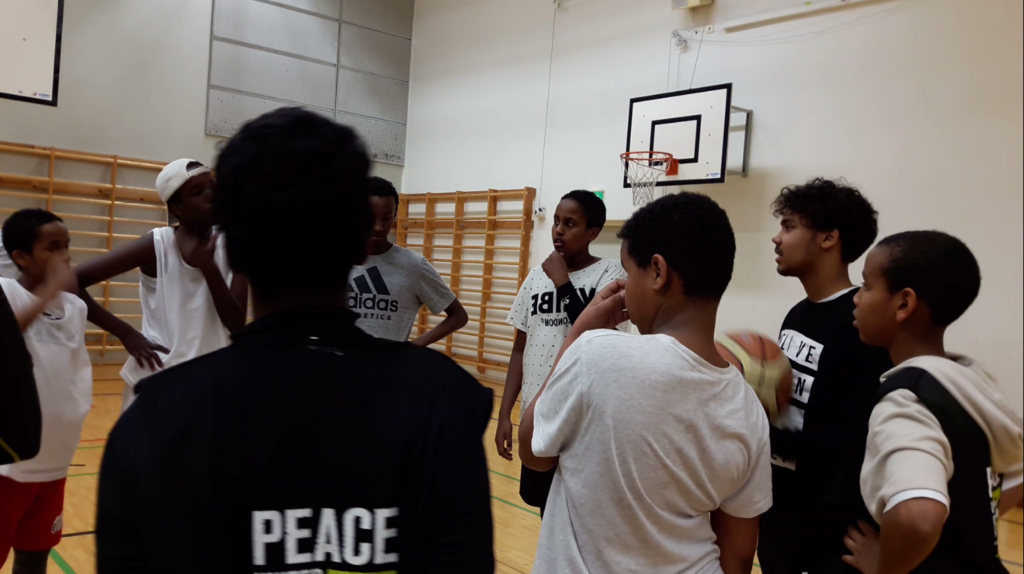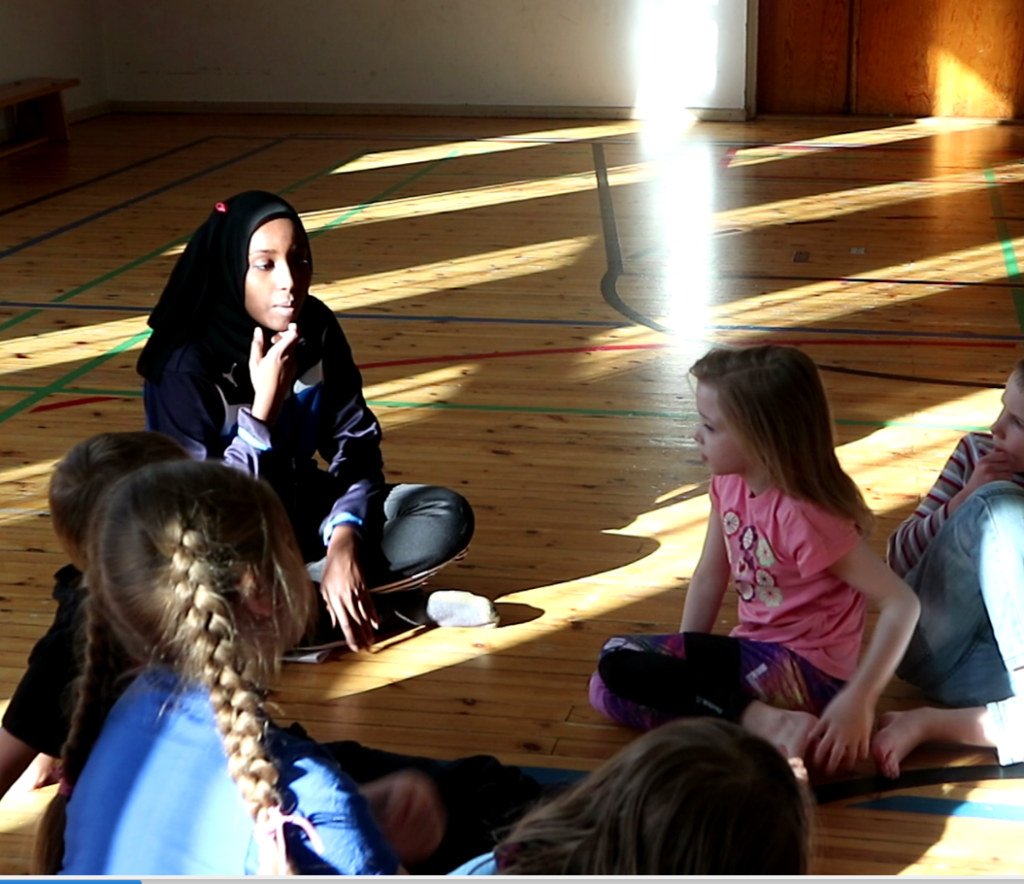Introduction to TPSR model
DESCRIPTION OF THE LEARNING UNIT
Description:
This course is based on the Teaching Personal and Social Responsibility (TPSR) model. This introductory lesson provides information about the model and practical ideas on how to plan, implement and evaluate a TPSR-based sport lesson.
Learning Outcomes:
- Learn to understand what the TPSR model is.
Keywords:
- empowerment-based leadership
- self-development
- transfer of life skills
How to follow this learning unit?
- Read the learning materials of this topic by clicking open the title banners.
- At the end of the sections, assess your understanding with a quiz or an exercise.
Background reading material
- Hellison, D. (2011). Teaching personal and social responsibility through physical activity (3rd ed.). Champaign, IL: Human Kinetics.
- Martinek, T. & Hellison, D. (2016). Teaching personal and social responsibility: Past, present, and future. Journal of Physical Education, Recreation & Dance, 87(5), 9-13. doi: 10.1080/07303084.2016.1157382
- Hanna-Mari Toivonen, Paul M. Wright, Mary Hassandra, Martin S. Hagger, Nelli Hankonen, Mirja Hirvensalo, Markus Talvio, Daniel Gould, Sami Kalaja, Tuija Tammelin, Kaarlo Laine & Taru Lintunen (2019): Training programme for novice physical activity instructors using Teaching Personal and Social Responsibility (TPSR) model: A programme development and protocol, International Journal of Sport and Exercise Psychology, DOI: 10.1080/1612197X.2019.1661268
TEACHING PERSONAL AND SOCIAL RESPONSIBILITY (TPSR) MODEL
The Teaching Personal and Social Responsibility (TPSR) model was developed over 40 years ago in Chicago. Dr. Don Hellison developed the model while working with low-income urban children in physical activity settings.
TPSR-based programmes use physical activity as a vehicle to teach children various life skills. The children practice the life skills in sport programmes and attempt to transfer the skills to other settings such as school, community, and home life.

The ultimate aim of TPSR-based programmes is to help children develop themselves as people and to learn to be responsible for the ways they conduct themselves and treat other people.
Applying the TPSR model (Hellison, 1985, 2011) in sport sessions can:
- help children with behavioural problems (e.g.. hyperactivity and inattention) to:
- calm down
- concentrate
- actively participate
- respect others
- cooperate with others
- help children in disadvantage positions in regard to their language skills and/or social status to:
- participate
- set and reach goals
- express their opinions
- evaluate themselves
The TPSR model was developed and has been widely used with underserved children, but the model can be used with any age people in any context.
The base of empirical and theoretical literature supporting the model is expanding. Read more …
VALUES & LEVELS
- Being youth-centred – focusing on the children’s needs, strengths, individuality, voice, and decision making capabilities
- Human decency – promoting positive relationships with others
- Holistic self-development – promoting students’ physical, emotional, social and cognitive development
- A way of being – practicing what you preach
Leader’s responsibilities
- Gradual empowerment – gradually share power with students and shift decision making to them
- Self-reflection – help students to get inside their own heads
- Embedding TPSR in the physical activity
- Addressing transfer of life skills
- Being relational with children – get to know every child as a human, provide a model of positive leader-child relationship
Children’s responsibilities (i.e. responsibility levels)
The children’s responsibilities are divided into responsibility levels:

- Respect for the rights and feelings of others
- Effort and cooperation
- Self-direction
- Caring and leadership
- Transfer of responsibility outside the physical activity setting
Levels one and two are essential for the development of responsibility and establishment of a positive learning environment.
Levels three and four enhance the learning environment by encouraging independent work, helping roles, and leadership roles.
Level five is the end goal, in which the aim is to apply the learned skills outside the learning environment and serve as a responsible role model to others.
Level 0 = Irresponsibility
- Negative use of language (e.g. cursing, talking over, blaming, criticizing, or name-calling)
- Physical violence
- Destroying property (e.g. breaking equipment or writing graffiti on the walls)
- Bothering others (e.g. interrupting or poking)
Level 1 = Respect
- Self-regulating (e.g. controlling temper and impulses, no physical violence, no negative use of language, not destroying property, or not bothering others)
- Solving problems peacefully (talking instead of fighting)
- Waiting for a turn
- Following rules
- Partially participating
Level 2 = Effort
- Participating in all activities (even if the activity is new, difficult or something he/she does not like)
- Not quitting
- Trying hard
Level 3 = Self-direction
- Working independently even when nobody is looking
- Setting goals and working toward them
- Making good choices (e.g. not joining friends who are goofing around)
- Completing extra tasks
Level 4 = Caring & leadership
- Listening to others
- Offering to take care of someone (e.g. sibling or pet)
- Helping others
- Inviting everybody (not just friends) to participate or be in his/her group
- Willing to work with every member of the group
- Cooperating
- Considering welfare and needs of others
- Leading or teaching others
Level 5 = Transfer of responsibility
- Understanding the value and relevance of the learned skills beyond the physical activity setting
- Applying the skills beyond the physical activity setting
- Being a positive role model for other
LIFE SKILLS

- Skills that enable individuals to succeed in the different environments in which they live (e.g. school, home, neighbourhood)
- Internal personal assets, characteristics and skills that can be facilitated or developed in physical activity setting and transferred for use in other settings
- Life skills are taught through demonstration, modelling and practice
- Life skills must be intentionally taught and fostered throughout the physical activity programme
- Behavioural
- E.g. Communicating effectively with peers and adults
- Cognitive
- E.g. Making effective decisions
- Interpersonal
- E.g. Being assertive
- Intrapersonal
- E.g. Setting goals
- Behavioural
Examples of life skills:
- Respect
- Self-regulation
- Effort (work ethic)
- Goal-setting
- Time-management
- Stress/pressure management
- Communication
- Peaceful problem solving
- Cooperation
- Leadership
LESSON FORMAT
Hellison created a lesson format to make it easier for practitioners to implement the essential parts of the model and to assure opportunities for children to practise and learn personal and social responsibility during each lesson.
The lesson format comprises of relational time, awareness talk, physical activity, and a group meeting and reflection time.
1. Relational time
Informal one on one interactions the leader has with the children.
- Can take place whenever an opportunity arises, (i.e. before or after the lesson, or during the lesson while the children are in transition)
- Help to create a welcoming environment and establish personal relationships with children
- An opportunity to chat, ask children how their day is going, and discuss about things that may be coming up or going on in their lives.
2. Awareness talk
A few minutes structured meeting that officially begins the lesson. The leader gathers children together to discuss about the lesson.
- Leader introduces the goals and objectives of the programme and the lesson.
- Leader introduced the concept of life skills.
- Leader goes over the plan for the day.
- Leader invites input from children.
3. Physical activity time
Constitutes majority of the lesson.
- Involves any age appropriate physical activity, exercise, or sport content.
- Integrates the teaching of responsibility with the teaching of the physical activity by
- employing teaching strategies to shift power to the children and put them in responsible roles.
- teaching life skills to the children.
- requiring children to make choices and considering the consequences.
- making children to solve conflicts peacefully.
4. Group meeting & reflection time
About five minutes before the end of the lesson, the programme leader gathers children together to discuss about the lesson.
1. Leader provides children an opportunity to share their opinion about the lesson and make suggestions.
- Children evaluate the lesson and give open feedback.
- Children comment on/evaluate the GROUP’s performance and cohesion.
- Children provide feedback to their peer-leaders and vice versa.
- Children reflect on/evaluate their OWN attitudes and behaviours during the lesson.
- The programme leader may ask children to share their self-reflections at this point verbally, with a hand signal, by writing a reflective journal, or by talking to the person next to them.
2. Discussion about the practiced life skill(s).
- Leader asks children what life skill(s) they were practicing during the lesson or leader tells children a name of a life skill that was practiced.
- Leader asks children to give examples of the practiced life skill during the lesson.
3. Discussion about the transfer of the learned skills beyond the physical activity setting.
- Leader asks children what other settings the practiced life skill(s) could be used at.
- Leader asks children to give examples of how the life skill(s) could be used in a specific setting, e.g. at school.
- Leader can help children to set goals for the use of a life skill.
4. Clear ending for the session
- Leader asks the group to choose a way to end the lesson, e.g. a group cheer or high fives.
TEACHING STRATEGIES
TPSR teaching strategies are a manageable list of concrete strategies that are consistent with the TPSR teaching philosophy and frequently used by experienced practitioners.
Many sport instructors model respect, set expectations, provide opportunities for success, foster social interaction, and assign management tasks. However, in TPSR-based programmes, leaders additionally frequently and systematically promote leadership, give voices and choices, involve children in assessment, and address transfer of life skills.
Under each teaching strategy, there are numerous specific tactics a leader might use, depending on the content, the nature of the group, etc.
Modelling respect
- Group leader models respectful behaviour and communication in interactions with the whole group and individual students
- For example, greets everybody, looks in the eyes, listens actively, does not roll eyes, does not curse, does not undermine anybody, does not lose temper, does not embarrass anybody, etc.
Setting expectations
- Group leader clearly communicates directions and behavioural expectations to children
- For example, creating group guidelines with the group, showing an example performance in addition to explaining an activity, explaining safe practices, etc.
Providing opportunities for success
- Group leader structures all activities so that all children have the opportunity to successfully participate and be included regardless of individual differences
- For example, starting with very easy level and progressing to more challenging, choosing wide range of activities requiring different set of skills, etc.
Fostering social interaction
- Group leader creates structures that allow children to have interactions with one another that are not directly controlled by the group leader
- For example, placing water bottles into one spot which encourages children to spontaneous interaction, asking children to put together a volleyball net which requires children to cooperate and use problem solving skills to find out how to do it, asking children to discuss in small group how to better cooperate, etc.
Assigning management tasks
- Group leader asks children to contribute to the management and organization of the lesson by taking on specific tasks or jobs
- For example, children taking attendance, setting up equipment, organizing equipment, officiating a game, keeping score/record, etc.
Promoting leadership

- Group leader allows children to lead or be in charge of their peers or the whole group
- For example, demonstrating for the class, leading a station, leading activities for a pair or the whole class, coaching a team, etc.
Giving voices
- Group leader creates opportunities for children to voice their opinions and offer suggestions
- For example, planning in small groups or in pairs, group discussions, asking questions, making suggestions, sharing opinions, evaluating the group leader, etc.
Giving choices
- Group leader creates opportunities for children to make decisions
- For example, choosing equipment, choosing a role, choosing a rule, choosing an activity, etc.
Involving children in assessment
- Group leader lets children engage in self-, group- and or peer-assessment
- For example, evaluation of skill development, behaviour, goals ,or attitude, or negotiation with the group leader about child’s progress in the programme, etc.
Addressing transfer of life skills
- Group leader directly addresses the life skills taught in the programme and their application outside the programme
- For example, the need to work hard and persevere in school, the importance of being a leader in your community, keeping your self-control to avoid a fight after school, setting goals to achieve what you want in sports, the need to be a good team player when you grow up and get a job, or the value of thinking for yourself to avoid peer-pressure
SCIENTIFIC BASIS OF THE TEACHING PERSONAL AND SOCIAL RESPONSIBILITY (TPSR) MODEL
The TPSR model has been field tested in school-based physical education as well as in after-school and community-based programs. TPSR has also been successfully implemented in many countries including Spain (Escartí, Gutiérrez, Pascual, & Marín, 2010), New Zealand (Gordon, 2010), Canada (Beaudoin, Brunelle, & Spallanzani, 2015), Turkey (Agbuga, Xiang, & McBride, 2015), Belize (Wright, Jacobs, Howell, & Ressler, 2018), Finland (Romar, Haag, & Dyson, 2015; Toivonen et al., 2019), and South Korea (Jung & Wright, 2012).
Research has shown that implementation of TPSR-based programmes can have positive behavioural, social, emotional, psychological, and educational outcomes (Pozo, Grao-Cruces, & Pérez-Ordás, 2018). Research on TPSR-based after-school programmes have also indicated that many students are able to apply the values and behaviours promoted in the programme in a classroom setting (Martinek, Schilling & Johnson, 2001; Wright, Li, Ding, & Pickering, 2010; Walsh, Ozaeta & Wright, 2010). However, the development of personal and social responsibility does not happen in a blink of an eye but takes years to develop and the development can continue throughout life.
References
Agbuga, B., Xiang, P., & McBride, R. E. (2015). Relationship between achievement goals and students’ self-reported personal and social responsibility behaviors. Spanish Journal of Psychology, 18, 1-9.
Beaudoin, S., Brunelle, J. P., & Spallanzani, C. (2015). The journey of two physical education and health teachers in learning to teach personal and social responsibility. Revue PHEnex Journal, 7(2), 1-32.
Escartí, A., Gutiérrez, M., Pascual, C., & Marín. D. (2010). Application of Hellison’s teaching personal and social responsibility model in physical education to improve self-efficacy for adolescents at risk of dropping-out of school. Spanish Journal of Psychology, 13(2), 667-76.
Gordon, B. (2010). An examination of the responsibility model in a New Zealand secondary school physical education program. Journal of Teaching Physical Education, 29(1), 21-37.
Hellison, D. (1985). Goals and strategies for teaching physical education. Champaign, IL: Human Kinetics.
Hellison, D. (2011). Teaching personal and social responsibility through physical activity (3rd ed.). Champaign, IL: Human Kinetics.
Jung, J., & Wright R. (2012). Application of Hellison’s responsibility model in South Korea: A multiple case study of “at-risk” middle school students in Physical Education. Agora, 14(2), 140-60.
Martinek T., Schilling T., & Johnson D. (2001). Transferring personal and social responsibility of underserved youth to the classroom. Urban Review, 33(1), 29-45.
Pozo, P., Grao-Cruces, A., & Pérez-Ordás, R. (2018). Teaching personal and social responsibility model-based programmes in physical education: A systematic review. European Physical Education Review, 24(1), 56-75. doi: 10.1177/1356336X16664749
Romar, J. E., Haag, E., & Dyson, B. (2015). Teachers’ experiences of the TPSR model in Physical Education. Agora, 17(3), 202-19.
Toivonen, H.-M., Wright, P. M., Hassandra, M., Hagger, M. S., Hankonen, N., Hirvensalo, M.,…Lintunen, T. (2019). Training programme for novice physical activity instructors using Teaching Personal and Social Responsibility (TPSR) model: A programme development and protocol. International Journal of Sport and Exercise Psychology. doi: 10.1080/1612197X.2019.1661268
Walsh, D. S., Ozaeta, J., & Wright, P. M. (2010).Transference of responsibility model goals to the school environment: Exploring the impact of a coaching club program. Physical Education & Sport Pedagogy, 15(1), 15-28.
Wright, P. M., Jacobs, J. M., Howell, S., & Ressler, J. D. (2018). Immediate outcomes and implementation of a sport for development coach education programme in Belize. Journal of Sport for Development, 6(10), 51-65.
Wright P. M., Li W., Ding S., & Pickering M. (2010). Integrating a personal and social responsibility program into a wellness course for urban high school students: Assessing implementation and educational outcomes. Sport, Education and Society, 15(3), 277-98.